Assignment No. 2: Over-policing of Aboriginal children in Australia: A System that Criminalises Aboriginal Children
Introduction
The over-representation of Aboriginal and Torres Strait Islander children in Australias criminal justice system points to racism and social injustice. Despite promises in agreements such as Close Deal, these children continue to be harshly treated, narrowly targeted by police and given limited access to change. This article explores the systemic issues facing young Aboriginal people through case studies and government research, focusing on the Royal Commission into Aboriginal Deaths in Custody (RCADIC). It highlights the need to change laws, youth detention systems and police practices to address racial discrimination. The impact on childrens lives and communities, and the countrys failure to implement long-term reform proposals, makes for an interesting topic.
Context & Case Study
Aboriginal and Torres Strait Islander children are underrepresented in the Australian criminal justice system. According to the Productivity Commission, Aboriginal youth are 22 times more likely to be imprisoned than non-Aboriginal youth. Despite the Royal Commissions recommendations in 1991, these children continue to face indiscriminate offending, limited participation in different programs and harsh policing. According to the 2021 World Congress on Justice for Children, Indigenous children are targeted by police for reasons of racial discrimination, as well as racism. These contradictory intersections emerge against a backdrop of police involvement in conflict, violence and the dispossession of Indigenous peoples. Accounts from families like Raymond Noel Lindsay Thomass illustrate the psychological horror of these encounters. Thomass untimely death during a police pursuit is an example of how early negative interactions with police can breed distrust and fear in Indigenous communities.
VALS also identified other problems with Victorias technology-based policing strategy, which classifies children as young online offenders due to inaccurate information. The New South Wales Suspect Target Management Program (STMP) also found that 72 per cent of children were Aboriginal or Torres Strait Islander. Such surveillance harms Aboriginal children because it perpetuates racial discrimination in the legal system. Additionally, minors continue to be victimised by the criminal justice system and, by failing to raise the age of criminal responsibility, they risk being imprisoned without parole for their behaviour.
Examination of Systemic Problems and Required Changes
Racial discrimination within the justice system and policing underlies the complex problem of Aboriginal child criminality. Scholars believe that racial discrimination encompasses more than just individual discrimination; this analysis will look at three key factors that contribute to the high crime rate among Aboriginal children: police practices, criminal law and consent.
Systemic Racism and Policing Practices
Relations between police and Aboriginal people remain strained due to past injustices. Police officers frequently treat Indigenous children with suspicion and hostility, stopping, searching, and arresting them for minor infractions, as VALS has highlighted. These traumatic events contribute to lifetime mistrust, as demonstrated by personal stories like the one of a 10-year-old Aboriginal kid who was threatened with violence during his first interaction with the police. Additionally, accountability and reform are hampered by the lack of openness surrounding police encounters, such as the unavailability of publicly accessible statistics on racial profiling (Police Accountability Project, 2021). These problems are made worse by predictive policing models, which use biassed algorithms to target Indigenous children disproportionately. The STMP's actions in New South Wales demonstrate how the employment of such instruments without adequate supervision encourages racial profiling. Police presence in schools, which was supposed to deter crime, has come under fire for boosting criminal connections with children who are already at risk. According to international data, minority adolescents are more likely to be arrested when police are present in educational settings, thus disconnecting them from support networks and education (Koorie adolescents Council, 2018).
Bail laws and the age of criminal responsibility
The present minimum age of criminal responsibility in Australia, which is 10 years old, has drawn a lot of criticism for being unfair and detrimental. Children under the age of 14 do not have the cognitive development necessary to comprehend the long-term effects of their activities, as research continuously shows (Royal Australasian College of Physicians, 2019). Only the Australian Capital Territory has pledged to raise the age to 14, leaving other states behind in spite of this evidence. In addition to lowering jail rates, raising the age would bring Australia into compliance with UN-promoted international human rights norms. Victoria has some of Australia's harshest bail regulations, in addition to antiquated criminal liability legislation. Despite evidence that jail exacerbates trauma and mental health difficulties in young people, Aboriginal children are subject to the same bail terms as adults. In contrast to a decline for non-Indigenous children in the same age group, remand orders for Aboriginal children aged 10 to 13 surged by 95?tween 2010 and 2019, according to the Commission for Children and Young People. The systemic obstacles Indigenous children encounter while trying to navigate a justice system that frequently criminalises their behaviour rather than offering them genuine care are reflected in these numbers.
Government inaction's effects and the necessity of reform
A lack of political will to address the underlying causes of Indigenous over-representation in the legal system is demonstrated by the continued failure to properly execute the Royal Commission on Aboriginal Deaths in Custody's findings. The Closing the Gap Implementation Plan is only one example of the various accords and programs that governments keep announcing without doing anything to combat systematic racism in police forces or guarantee accountability. Reconnecting Aboriginal children with their communities through diversion programs and trauma-informed care has been advocated by groups such as VALS on numerous occasions. These programs are essential, particularly for kids in foster care, because police participation frequently results in small behavioural problems that could be resolved with support services. Police are summoned to residential care units more often than family homes, according to the Sentencing Advisory Council's findings. This shows that guardians are not being properly trained and do not trust law enforcement to deal with vulnerable youth. Reducing the rate of incarceration of Aboriginal children requires all of RCIADICs recommendations to be put into practice. If the minimum age of criminal responsibility is raised to at least 14 and the criminal code is changed, children will not be locked into a cycle of imprisonment. Furthermore, if the police force is abolished and the police are removed from schools, Aboriginal students will be in a safe environment and able to focus on their education and personal development.
Conclusion
Aboriginal and Torres Strait Islander children continue to face racial discrimination in Australias criminal justice system. Despite public commitment to justice and fairness, inequality persists because the recommendations of the 1991 Royal Commission into Aboriginal Deaths (RCIADIC) have not yet been implemented. Police unfairly target these children, who face harsh legal and criminal penalties for behaviour that is often ignored by non-Indigenous children. As a result, Aboriginal young people are subject to criminal prosecution, injury, poverty and incarceration. The findings from time of death are only a small part of the wider reforms needed to address these issues. And to eliminate racial discrimination, police procedures need to be more accountable and transparent. To address social inequality and public health issues, force should not be used, but appropriate care and support should be provided. Addressing these issues requires a commitment to ending violence, greater transparency and greater freedom of expression. Raising the minimum age of criminal responsibility to at least 14, as recommended by human rights groups such as the United Nations, is an important first step. Changes to protection laws are also important. Policies that treat children as adults when seeking consent must be replaced by an approach that takes into account the vulnerability of Aboriginal children. Another important step is to remove the police from the classroom. Schools should be a safe environment that supports learning and personal development, not a place of fear and surveillance. Turning schools into prisons should ensure that Aboriginal children feel supported in their education. The population is weak. Australia needs to address the racism that exists there to create a justice system that treats all children equally. Important steps in the process include raising the age of criminal responsibility, changing the laws and removing the police from schools. But these changes need to be supported by sustained action to address the root causes of inequality and provide children with the services they need to do so in their own communities. Australia can begin to dismantle the unjust systems that have criminalised Aboriginal youth for generations and make a conscious decision to replace them with systems that promote justice.
Are you struggling to keep up with the demands of your academic journey? Don't worry, we've got your back!
Exam Question Bank is your trusted partner in achieving academic excellence for all kind of technical and non-technical subjects. Our comprehensive range of academic services is designed to cater to students at every level. Whether you're a high school student, a college undergraduate, or pursuing advanced studies, we have the expertise and resources to support you.
To connect with expert and ask your query click here Exam Question Bank

